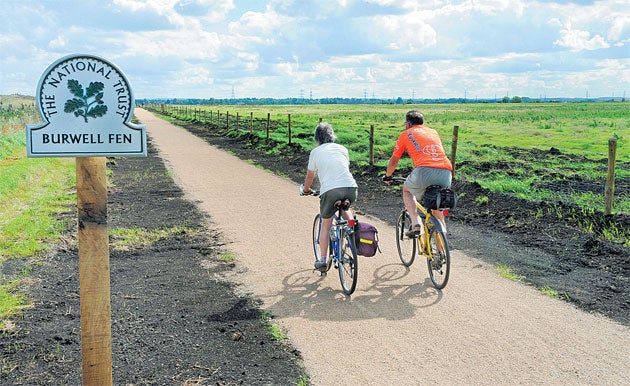Cambridge to Ely: Not a hill in sight – that's what I call cycling
Joanne O'Connor gets pedalling along The Lodes Way, the National Trust's new cross-country route between Cambridge and Ely

For a bike ride to be pleasurable, my requirements are very simple: there must be no hills. So a new cycle route through the Cambridgeshire Fens ought to be the answer to my prayers.
Having driven across this vast agricultural plateau many times, I confess I had written it off as bleak and monotonous, but today, sitting on a bike in the autumn sunshine, the absence of gradient is a blessing and a revelation.
To call the area flat seems like an understatement. In every direction, the vistas stretch to infinity. With the exception of the pylons, everything is horizontal. Puffs of white cloud march in serried ranks across an enormous blue sky. As I pedal along the rod-straight country roads, the sense of being a tiny speck in this huge landscape is exhilarating.
I'm on the Lodes Way, a new 14km route developed by the National Trust, which takes its name from the man-made channels that criss-cross the Fens and are believed to have been constructed in Saxon times to protect grazing land from flooding. The opening last week of a bridge over one of these waterways, Reach Lode, has opened up inaccessible tracts of the Fens to walkers and cyclists and has linked up with the Sustrans National Cycle Network to provide a cross-country route between the cities of Cambridge and Ely.
I opt for a circular route starting at the National Trust visitor centre at Wicken Fen. Before the Fens were drained in the 17th century, this was an isolated and inhospitable area, rife with malaria and superstition, the domain of wild-fowlers and fishermen who crossed the marshlands on stilts or in punts. Wicken Fen is the last undrained remnant of this ancient habitat, a haven for dragonflies, barn owls, otters and water vole. An ambitious 100-year project, the Wicken Fen Vision, has seen the National Trust gradually acquiring the surrounding farmlands with the aim of creating a new wetland nature reserve stretching between Wicken and Cambridge.
Leaving the visitor centre, I pass the peaceful reed beds of Wicken and head across some of this newly reclaimed land, where herds of Highland cattle and Konik ponies graze. When the peat soil was drained it shrank, with the odd result that the waterways now stand well above the level of the land. This is particularly apparent on Burwell Fen, which fell three metres and is now one of the lowest points in the country.
At the village of Lode, I make a short detour to visit Anglesey Abbey, a Jacobean-style manor house owned by the National Trust, for tea and cake and a quick peek at the famed dahlia gardens, before circling back to Wicken via the fenside villages of Reach, Swaffham Prior and Burwell. What the route lacks in hills it makes up for in tea shops, making it perfect for even the most fair-weather of cyclists.
From Wicken, it's not far to the tiny hamlet of Sutton Gault where I have booked dinner and a room at the Anchor Inn. On the banks of the New Bedford River, surrounded by fenland, the inn was built in the 17th century to house the Scottish prisoners of war who were digging the ditches. It's a cosy and atmospheric bolthole with low ceilings, wood-panelled walls and an open fireplace. I had heard the food was excellent and my meal of smoked salmon from the Farm River Smokery at nearby Bottisham, and venison from the Denham estate in Suffolk does not disappoint.
In the morning I open the curtains to find the surrounding fields covered in a white blanket of mist. It's easy to see how myths and superstitions would thrive in such a place. And who better to share some of these stories than Peter Carter, the last traditional eel catcher in the Fens. Eel trapping, reed-cutting and wildfowling have run in his family for more than 500 years and with his battered hat and vowels as flat as the country that shaped them, Carter looks and sounds like a relic from a bygone era. He shows us how to send an eel to sleep by tickling its belly and how to weave a willow trap but he remains tight-lipped about where he catches his eels. "It takes a lifetime to learn how the eels run. No eel catcher will tell anyone where they set their traps."
Eels were once so bountiful that they were used as currency in these parts, paying for the stone that built Ely Cathedral (the name of the city means "place of eels"). But stocks have fallen drastically in the past 30 years and this way of life would be unsustainable without the extra income Peter gets from giving talks and demonstrations. But it's clear he'd much rather be out on the river with the otters and kingfishers for company. "This is the only life I know and I want to keep doing it till I drop," he says.
With initiatives such as the Wicken Fen Vision and the Lodes Way promoting interest in this unique landscape and helping to preserve its wildlife and traditions, hopefully he'll get his wish.
How to get there
For information on The Lodes Way and events such as The Fenman's Day, contact Wicken Fen visitor centre (01353 720274; wicken.org.uk). Cycle hire will be available from Wicken Fen and Anglesey Abbey from spring 2011.
The Anchor Inn at Sutton Gault (01353 778537; anchor-inn-restaurant.co.uk) offers B&B in a double room from £79.50 per night.
Subscribe to Independent Premium to bookmark this article
Want to bookmark your favourite articles and stories to read or reference later? Start your Independent Premium subscription today.

Join our commenting forum
Join thought-provoking conversations, follow other Independent readers and see their replies